Sir John Monash, Personal Files Book 13, 1 June - 1 July 1916, Part 7
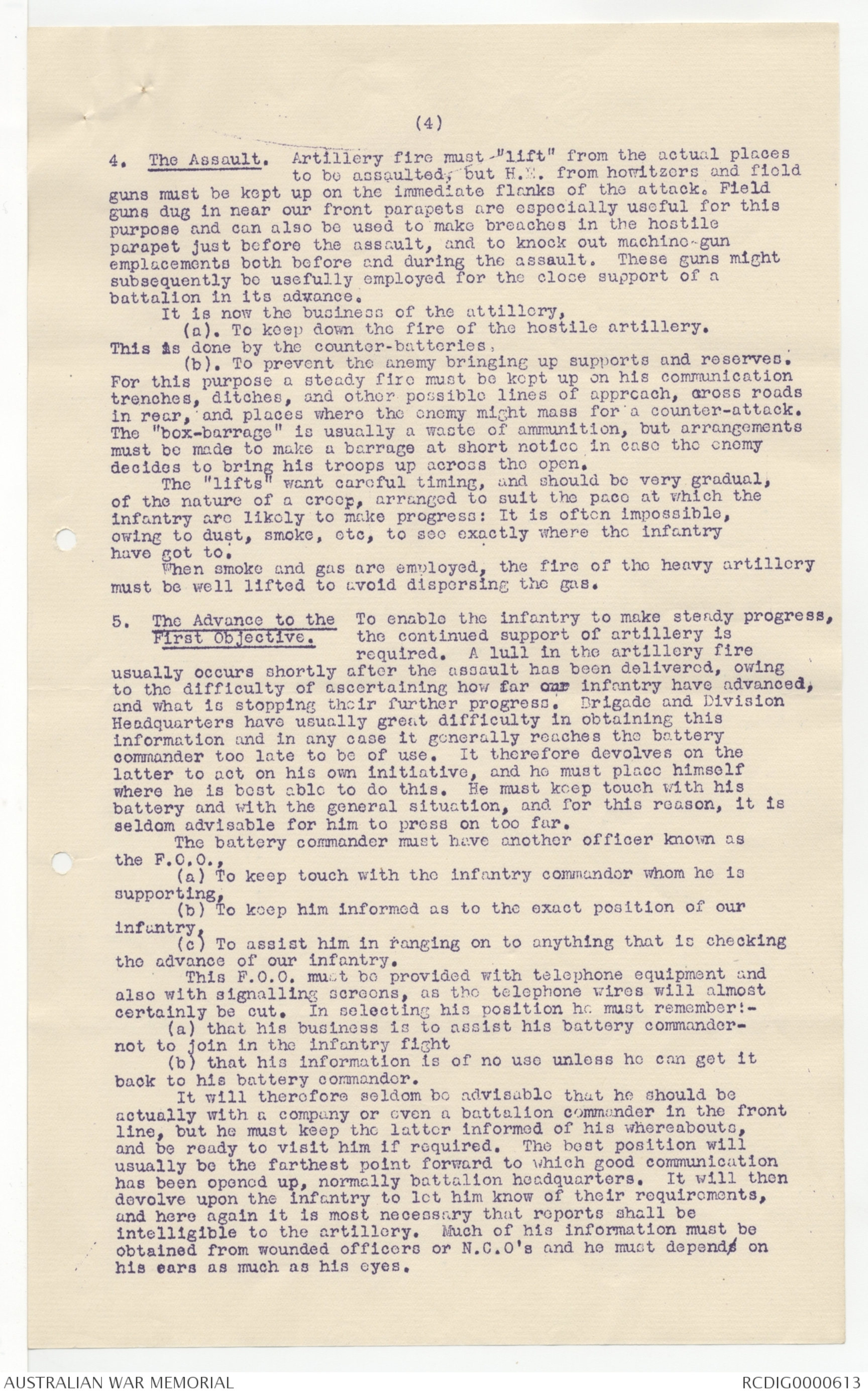
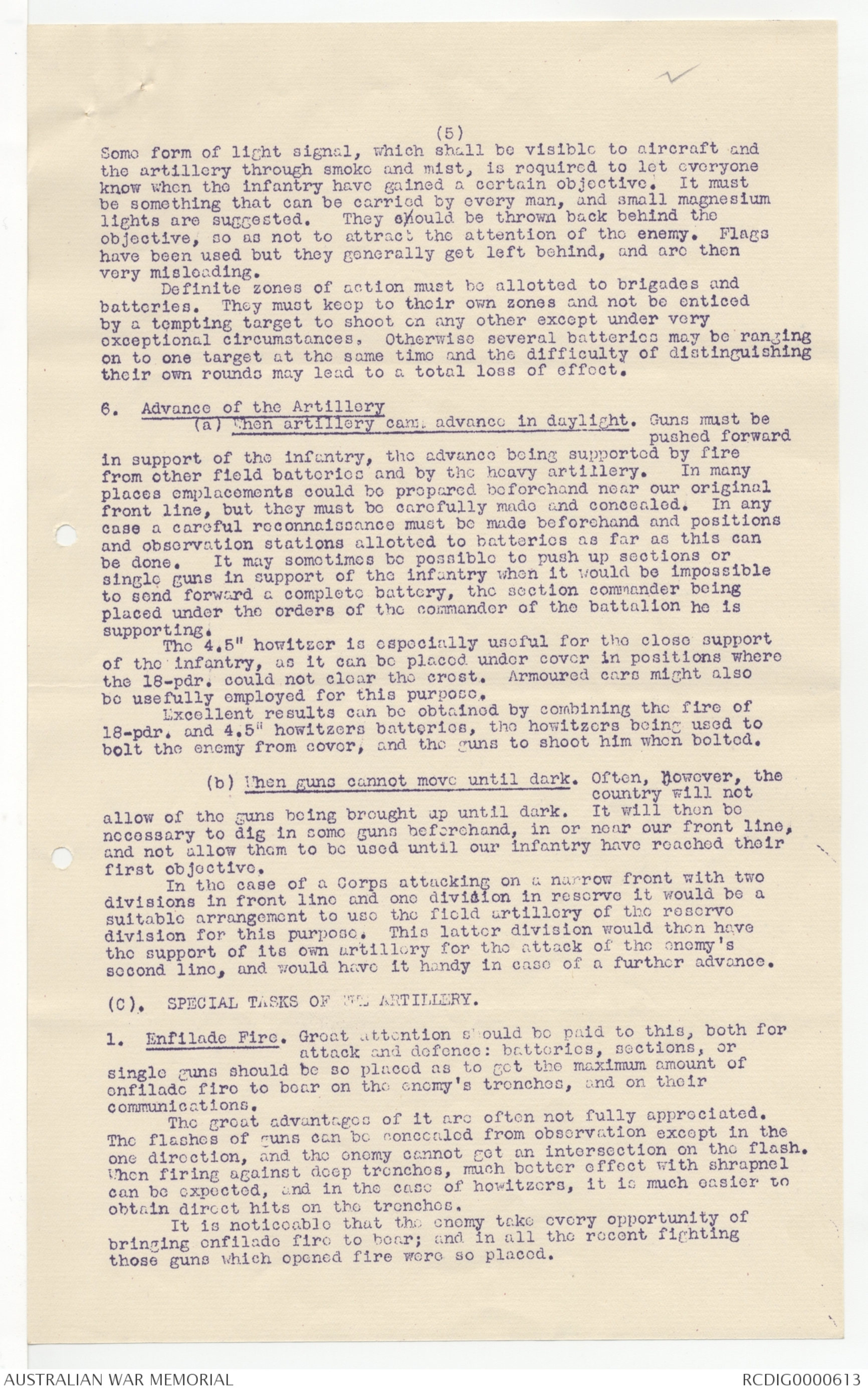
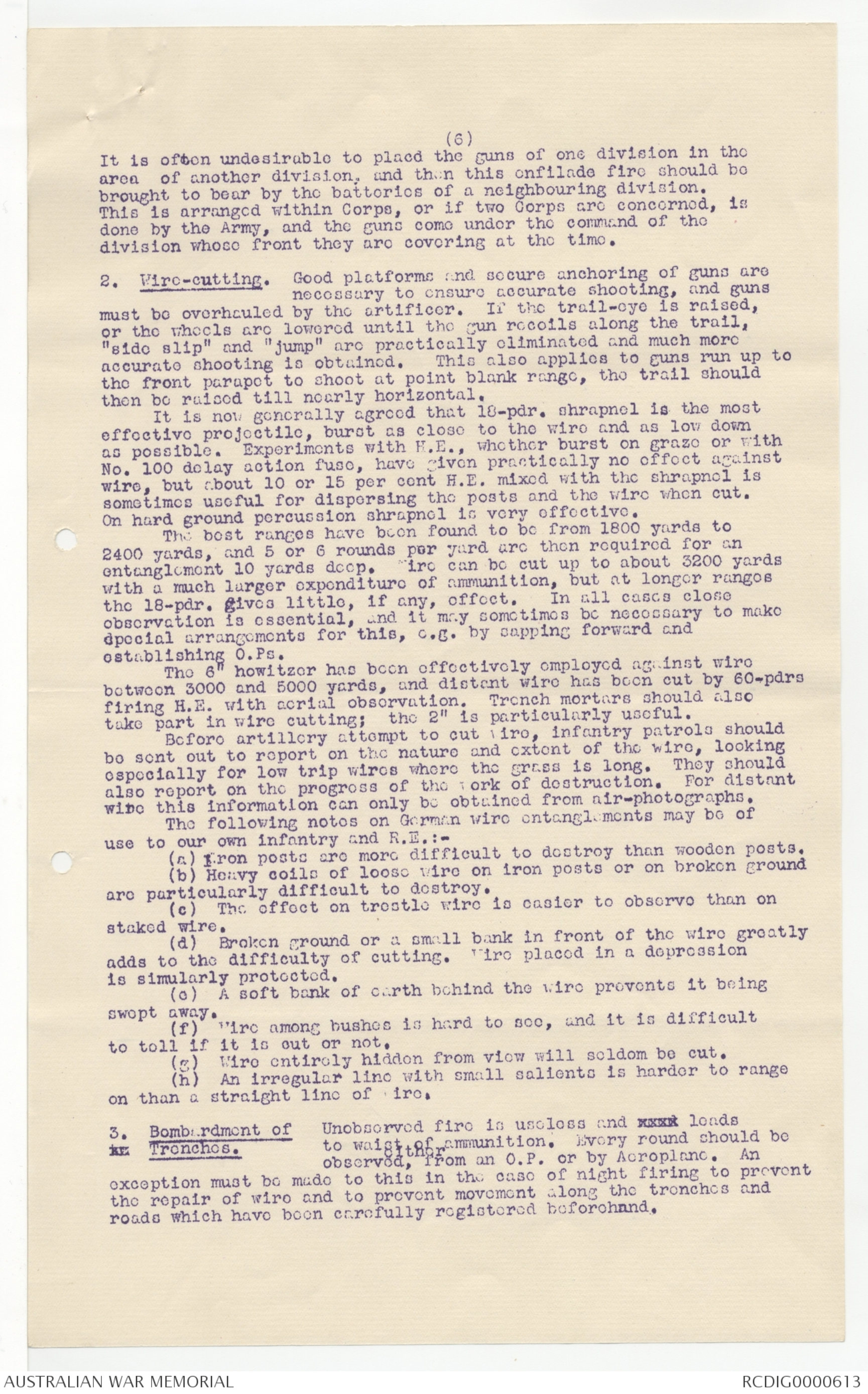
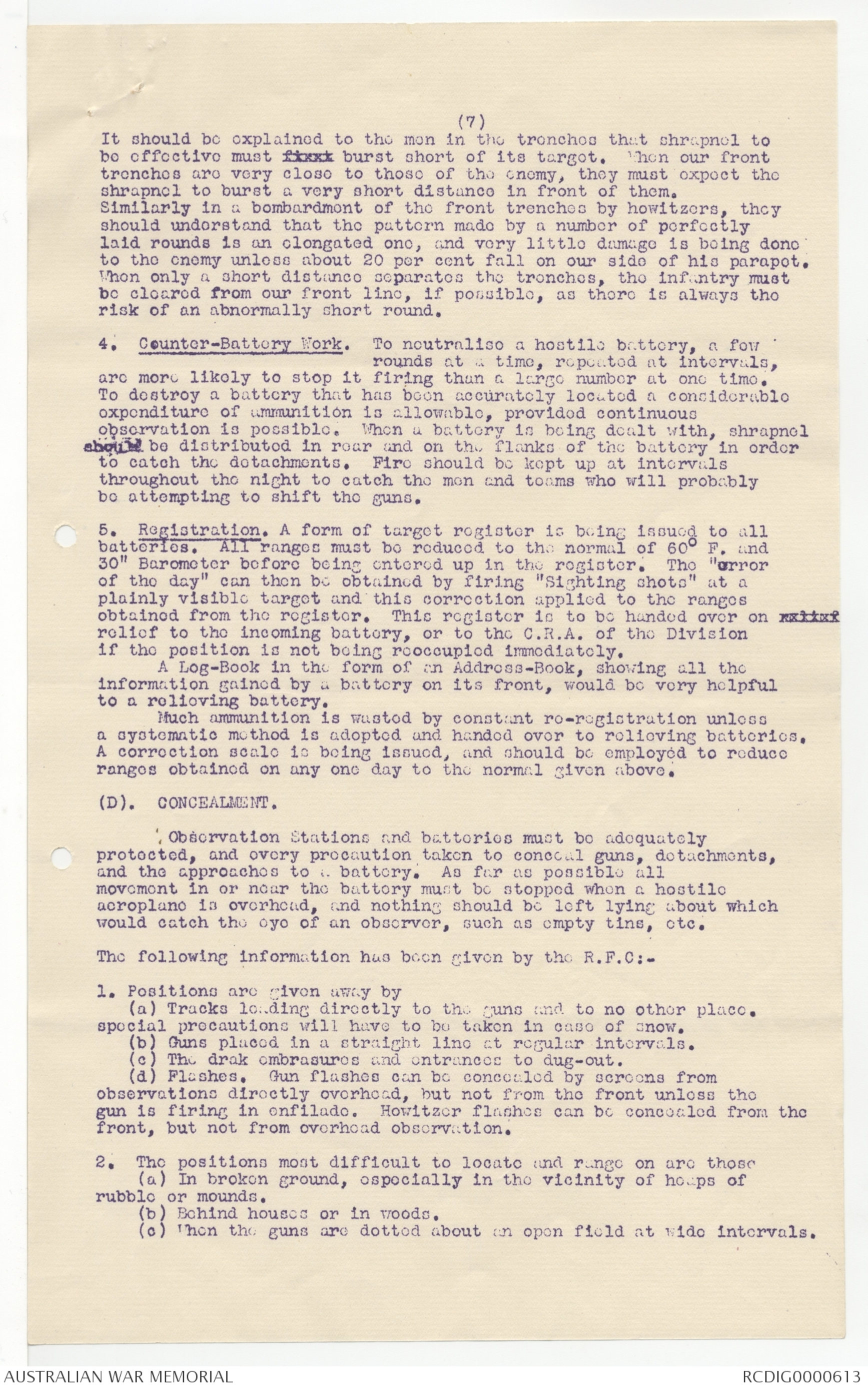
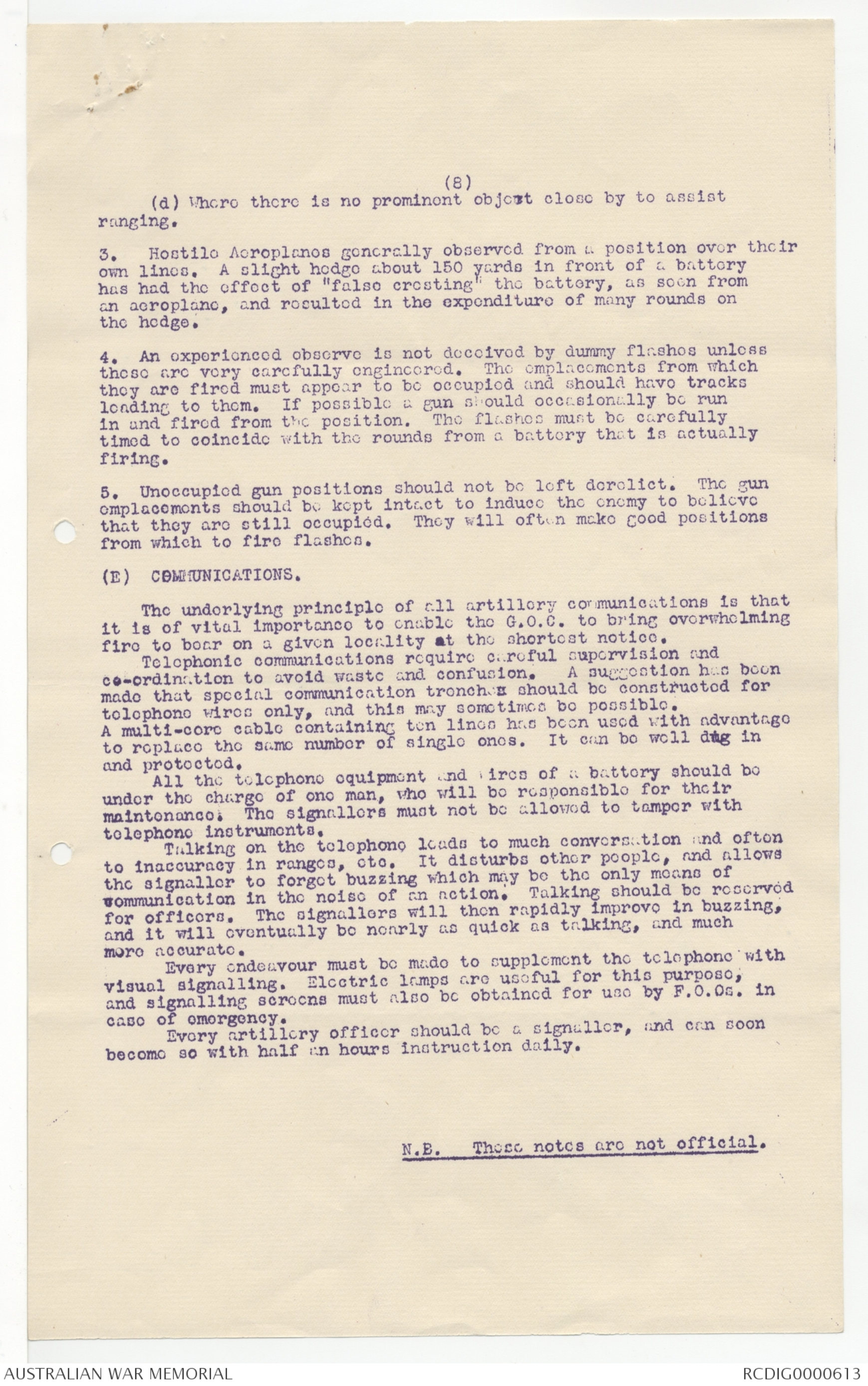
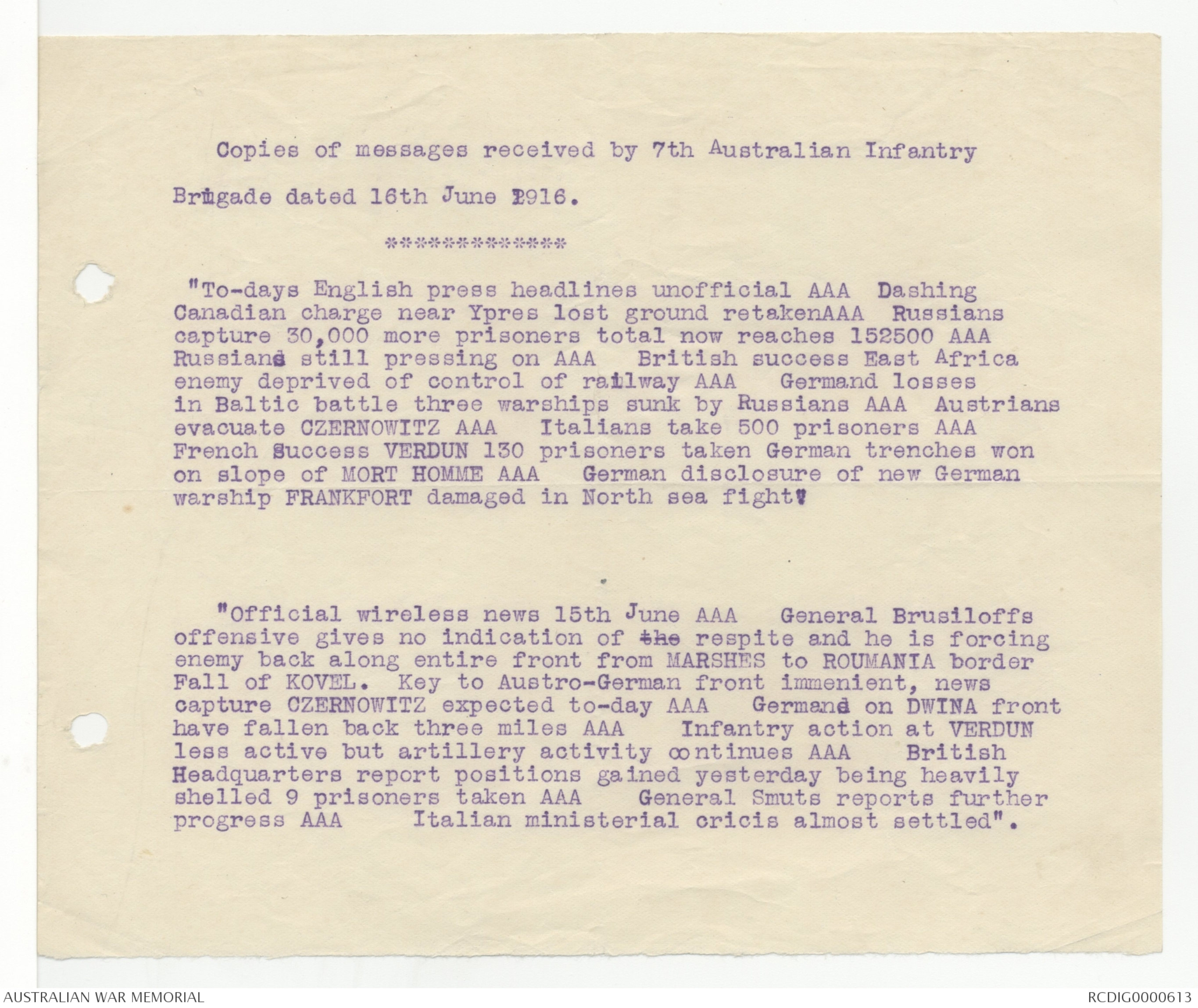
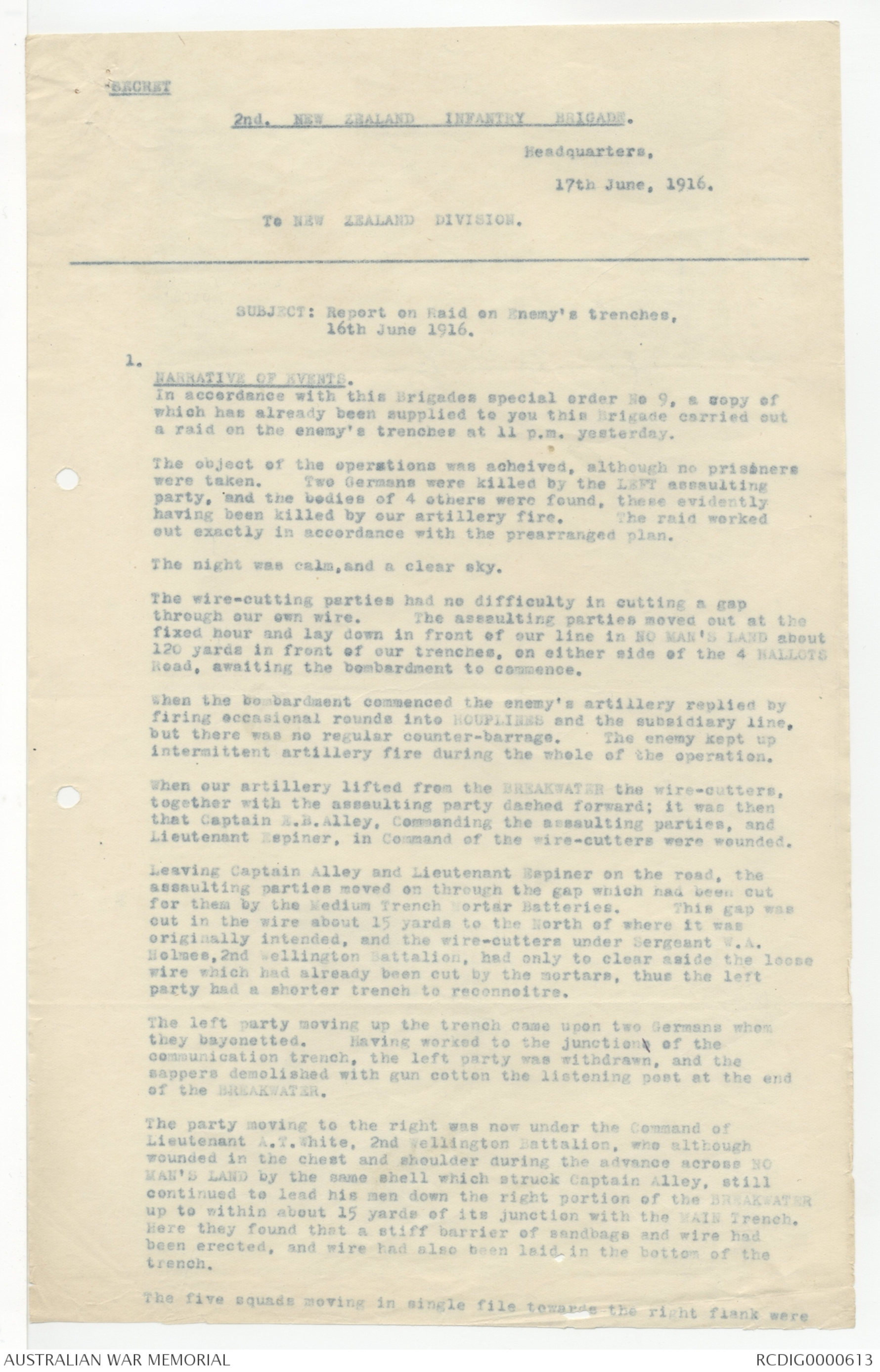
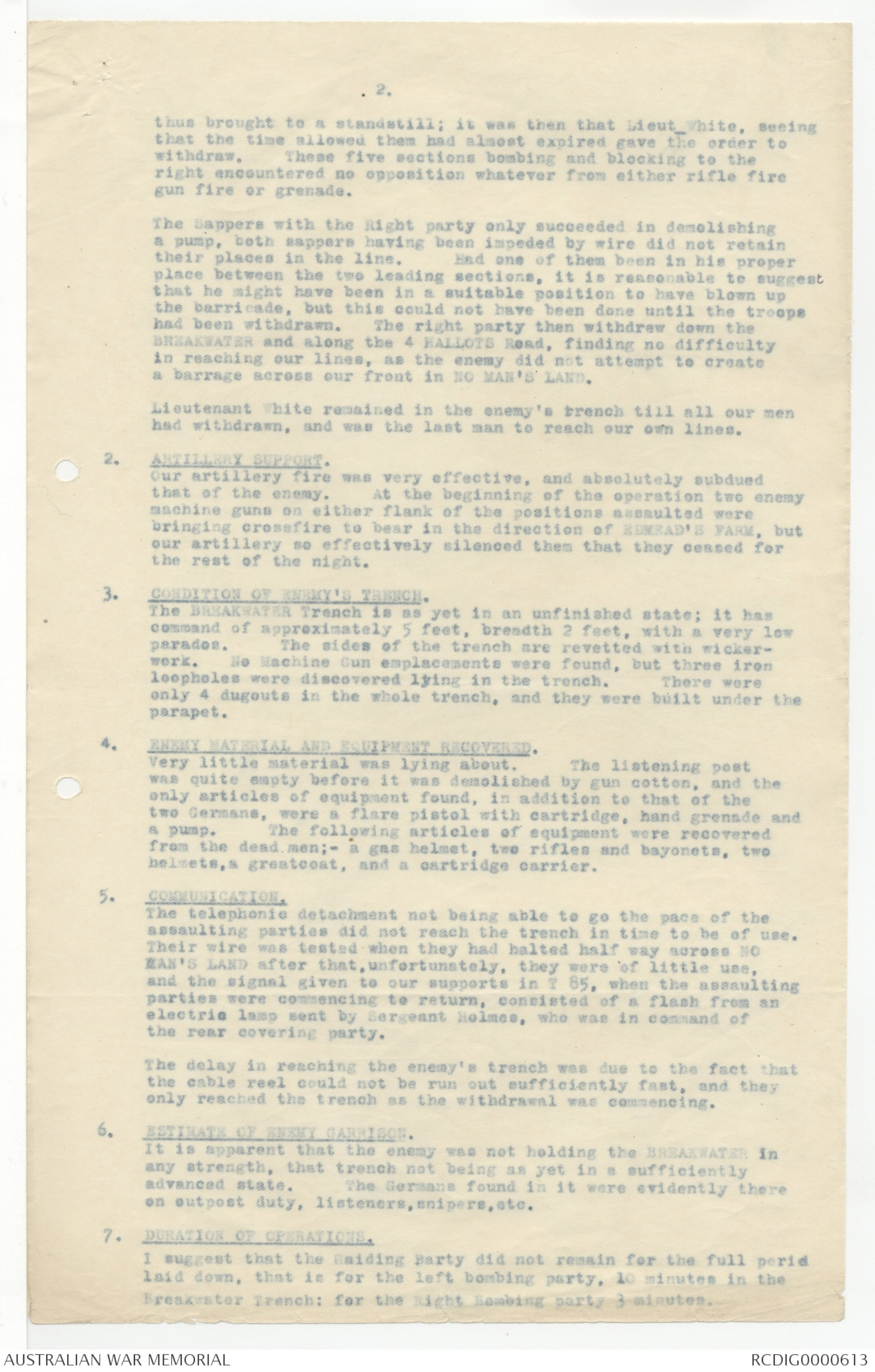
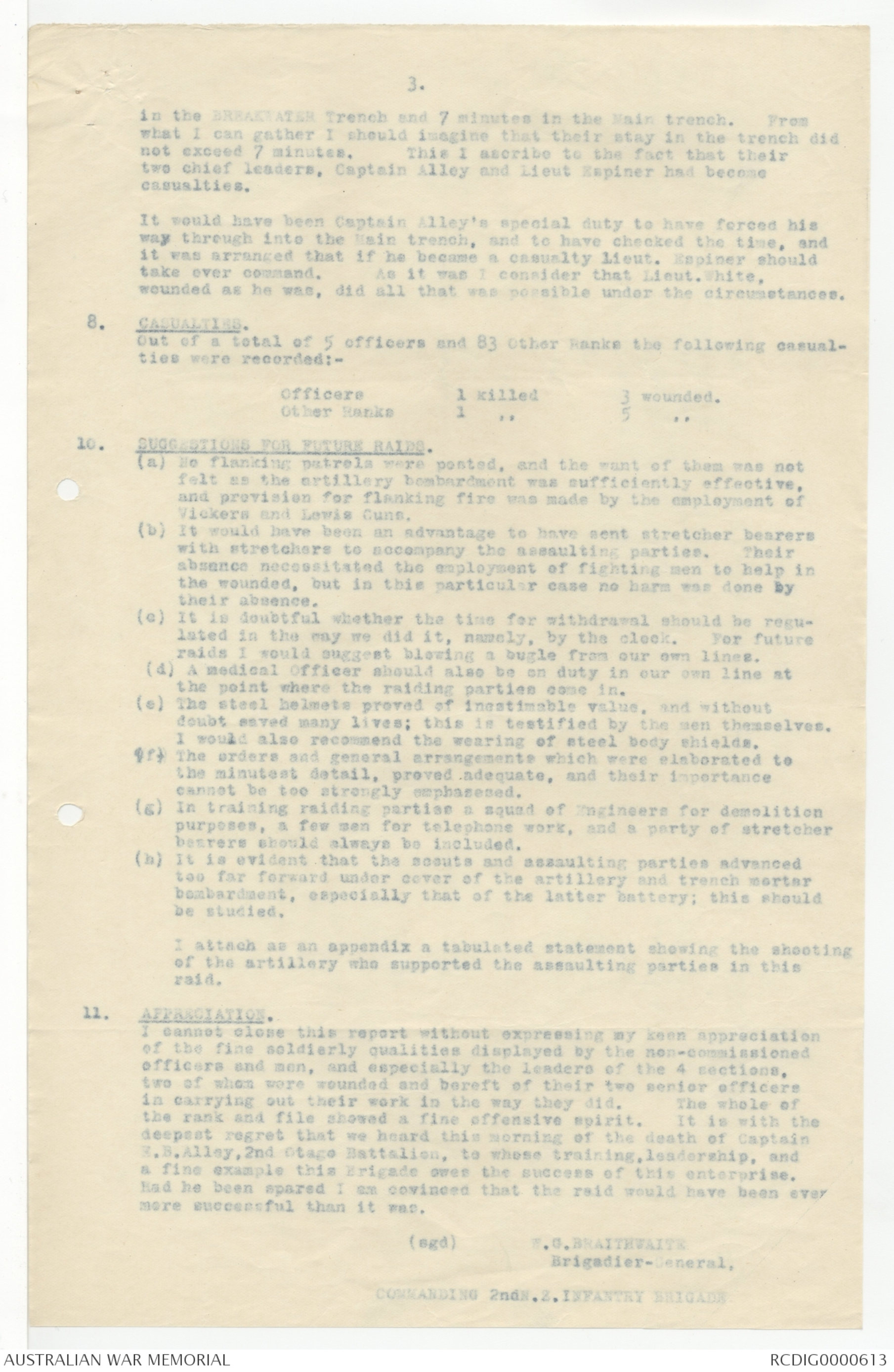
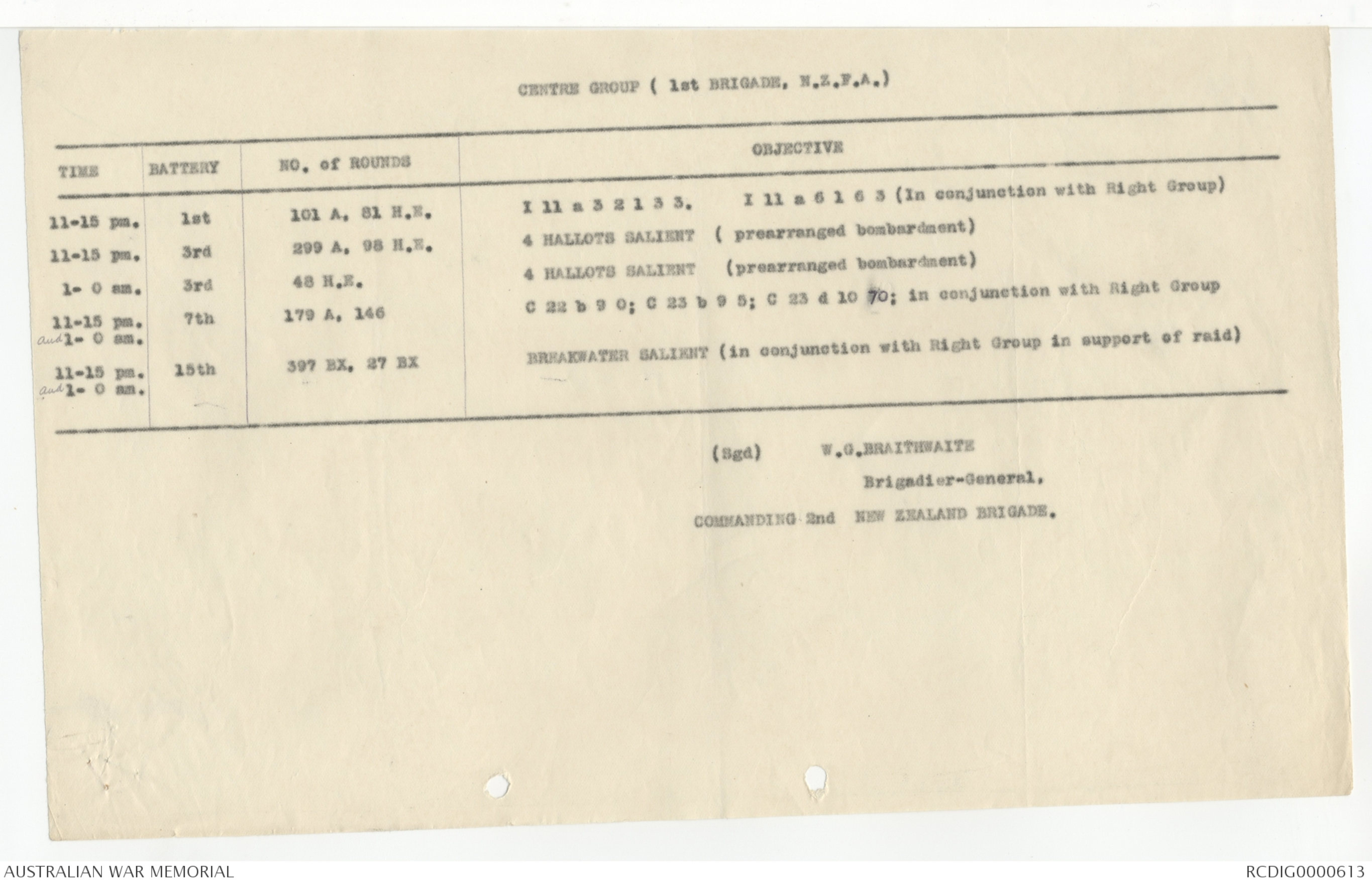
(4)
4. The Assault. Artillery fire must "lift" from the actual places
to be assaulted; but H.E. from howitzers and field
guns must be kept up on the immediate flanks of the attack. Field
guns dug in near our front parapets are especially useful for this
purpose and can also be used to make breaches in the hostile
parapet just before the assault, and to knock out machine-gun
emplacements both before and during the assault. These guns might
subsequently be usefully employed for the close support of a
battalion in its advance.
It is now the business of the artillery,
(a). To keep down the fire of the hostile artillery.
This is done by the counter-batteries,
(b). To prevent the enemy bringing up supports and reserves.
For this purpose a steady fire must be kept up on his communication
trenches, ditches, and other possible lines of approach, across roads
in rear, and places where the enemy might mass for a counter-attack.
The "box-barrage" is usually a waste of ammunition, but arrangements
must be made to make a barrage at short notice in case the enemy
decides to bring his troops up across the open.
The "lifts" want careful timing, and should be very gradual,
of the nature of a creep, arranged to suit the pace at which the
infantry are likely to make progress: It is often impossible,
owing to dust, smoke, etc, to see exactly where the infantry
have got to.
When smoke and gas are employed, the fire of the heavy artillery
must be well lifted to avoid dispersing the gas.
5. The Advance to the
First Objective. To enable the infantry to make steady progress,
the continued support of artillery is
required. A lull in the artillery fire
usually occurs shortly after the assault has been delivered, owing
to the difficulty of ascertaining how far our infantry have advanced,
and what is stopping their further progress. Brigade and Division
Headquarters have usually great difficulty in obtaining this
information and in any case it generally reaches the battery
commander too late to be of use. It therefore devolves on the
latter to act on his own initiative, and he must place himself
where he is best able to do this. He must keep touch with his
battery and with the general situation, and for this reason, it is
seldom advisable for him to press on too far.
The battery commander must have another officer known as
the F.O.O.,
(a) To keep touch with the infantry commander whom he is
supporting,
(b) To keep him informed as to the exact position of our
infantry,
(c) To assist him in ranging on to anything that is checking
the advance of our infantry.
This F.O.O. must be provided with telephone equipment and
also with signalling screens, as the telephone wires will almost
certainly be cut. In selecting his position he must remember:-
(a) that his business is to assist his battery commander-
not to join in the infantry fight
(b) that his information is of no use unless he can get it
back to his battery commander.
It will therefore seldom be advisable that he should be
actually with a company or even a battalion commander in the front
line, but he must keep the latter informed of his whereabouts,
and be ready to visit him if required. The best position will
usually be the farthest point forward to which good communication
has been opened up, normally battalion headquarters. It will then
devolve upon the infantry to let him know of their requirements,
and here again it is most necessary that reports shall be
intelligible to the artillery. Much of his information must be
obtained from wounded officers or N.C.O's and he must depends on
his ears as much as his eyes.
(5)
Some form of light signal, which shall be visible to aircraft and
the artillery through smoke and mist, is required to let everyone
know when the infantry have gained a certain objective. It must
be something that can be carried by every man, and small magnesium
lights are suggested. They chould be thrown back behind the
objective, so as not to at tract the attention of the enemy. Flags
have been used but they generally get left behind, and are then
very misleading.
Definite zones of action must be allotted to brigades and
batteries. They must keep to their own zones and not be enticed
by a tempting target to shoot on any other except under very
exceptional circumstances. Otherwise several batteries may be ranging
on to one target at the same time and the difficulty of distinguishing
their own rounds may lead to a total loss of effect.
6. Advance of the Artillery
(a) When artillery cam advance in daylight. Guns must be
pushed forward
in support of the infantry, the advance being supported by fire
from other field batteries and by the heavy artillery. In many
places emplacements could be prepared beforehand near our original
front line, but they must be carefully made and concealed. In any
case a careful reconnaissance must be made beforehand and positions
and observation stations allotted to batteries as far as this can
be done. It may sometimes be possible to push up sections or
single guns in support of the infantry when it would be impossible
to send forward a complete battery, the section commander being
placed under the orders of the commander of the battalion he is
supporting.
The 4.5" howitzer is especially useful for the close support
of the infantry, as it can be placed under cover in positions where
the 18-pdr. could not clear the crest. Armoured cars might also
be usefully employed for this purpose.
Excellent results can be obtained by combining the fire of
18-pdr. and 4.5 howitzers batteries, the howitzers being used to
bolt the enemy from cover, and the guns to shoot him when bolted.
(b) When guns cannot move until dark. Often, However, the
country will not
allow of the guns being brought up until dark. It will then be
necessary to dig in some guns beforehand, in or near our front line,
and not allow them to be used until our infantry have reached their
first objective.
In the case of a Corps attacking on a narrow front with two
divisions in front line and one division in reserve it would be a
suitable arrangement to use the field artillery of the reserve
division for this purpose. This latter division would then have
the support of its own artillery for the attack of the enemy's
second line, and would have it handy in case of a further advance.
(C). SPECIAL TASKS OF THE ARTILLERY.
1. Enfilade Fire. Great attention should be paid to this, both for
attack and defence: batteries, sections, or
single guns should be so placed as to get the maximum amount of
enfilade fire to bear on the enemy's trenches, and on their
communications.
The great advantages of it are often not fully appreciated.
The flashes of guns can be concealed from observation except in the
one direction, and the enemy cannot get an intersection on the flash.
When firing against deep trenches, much better effect with shrapnel
can be expected , and in the case of howitzers, it is much easier to
obtain direct hits on the trenches.
It is noticeable that the enemy take every opportunity of
bringing enfilade fire to bear; and in all the recent fighting
those guns which opened fire were so placed.
(6)
It is often undesirable to placd the guns of one division in the
area of another division, and then this enfilade fire should be
brought to bear by the batteries of a neighbouring division.
This is arranged within Corps, or if two Corps are concerned, is
done by the Army, and the guns come under the command of the
division whose front they are covering at the time.
2. Wire-cutting. Good platforms and secure anchoring of guns are
necessary to ensure accurate shooting, and guns
must be overhauled by the artificer. If the trail-eye is raised,
or the wheels are lowered until the gun recoils along the trail,
"side slip" and "jump" are practically eliminated and much more
accurate shooting is obtained. This also applies to guns run up to
the front parapet to shoot at point blank range, the trail should
then be raised till nearly horizontal.
It is now generally agreed that 18-pdr. shrapnel is the most
effective projectile, burst as close to the wire and as low down
as possible. Experiments with H.E., whether burst on graze or with
No. 100 delay action fuse, have given practically no effect against
wire, but about 10 or 15 per cent H.E. mixed with the shrapnel is
sometimes useful for dispersing the posts and the wire when cut.
On hard ground percussion shrapnel is very effective.
The best ranges have been found to be from 1800 yards to
2400 yards, and 5 or 6 rounds per yard are then required for an
entanglement 10 yards deep. Wire can be cut up to about 3200 yards
with a much larger expenditure of ammunition, but at longer ranges
the 18-pdr. gives little, if any, effect. In all cases close
observation is essential, and it may sometimes be necessary to make
special arrangements for this, e.g. by sapping forward and
establishing O.Ps.
The 6" howitzer has been effectively employed against wire
between 3000 and 5000 yards, and distant wire has been cut by 60-pdrs
firing H.E. with aerial observation. Trench mortars should also
take part in wire cutting; the 2" is particularly useful.
Before artillery attempt to cut wire, infantry patrols should
be sent out to report on the nature and extent of the wire, looking
especially for low trip wires where the grass is long. They should
also report on the progress of the work of destruction. For distant
wire this information can only be obtained from air-photographs.
The following notes on German wire entanglements may be of
use to our own infantry and R.E.:-
(a) Iron posts are more difficult to destroy than wooden posts.
(b) Heavy coils of loose wire on iron posts or on broken ground
are particularly difficult to destroy.
(c) The effect on trestle wire is easier to observe than on
staked wire.
(d) Broken ground or a small bank in front of the wire greatly
adds to the difficulty of cutting. Wire placed in a depression
is similarly protected.
(e) A soft bank of earth behind the wire prevents it being
swept away.
(f) Wire among bushes is hard to see, and it is difficult
to tell if it is cut or not.
(g) Wire entirely hidden from view will seldom be cut.
(h) An irregular line with small salients is harder to range
on than a straight line of wire.
3. Bombardment
xx of Trenches. Unobserved fire is useless and xxxx lends
to waist of ammunition. Every round should be
observed, ^either from an O.P. or by Aeroplane. An
exception must be made to this in the case of night firing to prevent
the repair of wire and to prevent movement along the trenches and
roads which have been carefully registered beforehand,
(7)
It should be explained to the men in the trenches that shrapnel to
be effective must first burst short of its target. When our front
trenches are very close to those of the enemy, they must expect the
shrapnel to burst a very short distance in front of them.
Similarly in a bombardment of the front trenches by howitzers, they
should understand that the pattern made by a number of perfectly
laid rounds is an elongated one, and very little damage is being done
to the enemy unless about 20 per cent fall on our side of his parapet.
When only a short distance separates the trenches, the infantry must
be cleared from our front line, if possible, as there is always the
risk of an abnormally short round.
4. Counter-Battery Work. To neutralise a hostile battery, a few
rounds at a time, repeated at intervals,
are more likely to stop it firing than a large number at one time.
To destroy a battery that has been accurately located a considerable
expenditure of ammunition is allowable, provided continuous
observation is possible. When a battery is being dealt with, shrapnel
should be distributed in rear and on the flanks of the battery in order
to catch the detachments. Fire should be kept up at intervals
throughout the night to catch the men and teams who will probably
be attempting to shift the guns.
5. Registration. A form of target register is being issued to all
batteries. All ranges must be reduced to the normal of 60° F. and
30" Barometer before being entered up in the register. The "error
of the day" can then be obtained by firing "Sighting shots" at a
plainly visible target and this correction applied to the ranges
obtained from the register. This register is to be handed over on xxxxx
relief to the incoming battery, or to the C.R.A. of the Division
if the position is not being reoccupied immediately.
A Log-Book in the form of an Address-Book, showing all the
information gained by a battery on its front, would be very helpful
to a relieving battery.
Much ammunition is wasted by constant re-registration unless
a systematic method is adopted and handed over to relieving batteries.
A correction scale is being issued, and should be employed to reduce
ranges obtained on any one day to the normal given above.
(D). CONCEALMENT.
Observation Stations and batteries must be adequately
protected, and every precaution taken to conceal guns, detachments,
and the approaches to a battery. As far as possible all
movement in or near the battery must be stopped when a hostile
aeroplane is overhead, and nothing should be left lying about which
would catch the eye of an observer, such as empty tins, etc.
The following information has been given by the R.F.C:-
1. Positions are given away by
(a) Tracks leading directly to the guns and to no other place.
special precautions will have to be taken in case of snow.
(b) Guns placed in a straight line at regular intervals.
(c) The drak embrasures and entrances to dug-out.
(d) Flashes. Gun flashes can be concealed by screens from
observations directly overhead, but not from the front unless the
gun is firing in enfilade. Howitzer flashes can be concealed from the
front, but not from overhead observation.
2. The positions most difficult to locate and range on are those
(a) In broken ground, especially in the vicinity of heaps of
rubble or mounds.
(b) Behind houses or in woods.
(c) When the guns are dotted about an open field at wide intervals.
(8)
(d) Where there is no prominent object close by to assist
ranging.
3. Hostile Aeroplanes generally observed from a position over their
own lines. A slight hedge about 150 yards in front of a battery
has had the effect of "false cresting" the battery, as seen from
an aeroplane, and resulted in the expenditure of many rounds on
the hedge.
4. An experienced observe is not deceived by dummy flashes unless
these are very carefully engineered. The emplacements from which
they are fired must appear to be occupied and should have tracks
leading to them. If possible a gun should occasionally be run
in and fired from the position. The flashes must be carefully
timed to coincide with the rounds from a battery that is actually
firing.
5. Unoccupied gun positions should not be 1eft derelict. The gun
emplacements should be kept intact to induce the enemy to believe
that they are still occupied. They will often make good positions
from which to fire flashes.
(E) COMMUNICATIONS.
The underlying principle of all artillery communications is that
it is of vital importance to enable the G.O.C. to bring overwhelming
fire to bear on a given locality at the shortest notice.
Telephonic communications require careful supervision and
co-ordination to avoid waste and confusion. A suggestion has been
made that special communication trenches should be constructed for
telephone wires only, and this may sometimes be possible.
A multi-core cable containing ten lines has been used with advantage
to replace the same number of single ones. It can be well dug in
and protected.
All the telephone equipment and wires of a battery should be
under the charge of one man, who will be responsible for their
maintenance. The signallers must not be allowed to tamper with
telephone instruments.
Talking on the telephone leads to much conversation and often
to inaccuracy in ranges, etc. It disturbs other people, and allows
the signaller to forget buzzing which may be the only means of
communication in the noise of an action. Talking should be reserved
for officers. The signallers will then rapidly improve in buzzing,
and it will eventually be nearly as quick as talking, and much
more accurate.
Every endeavour must be made to supplement the telephone with
visual signalling. Electric lamps are useful for this purpose,
and signalling screens must also be obtained for use by F.O.Os. in
case of emergency.
Every artillery officer should be a signaller, and can soon
become so with half an hours instruction daily.
N.B. These notes are not official.
Copies of messages received by 7th Australian Infantry
Brigade dated 16th June 1916.
"To-days English press headlines unofficial AAA Dashing
Canadian charge near Ypres lost ground retakenAAA Russians
capture 30,000 more prisoners total now reaches 152500 AAA
Russians still pressing on AAA British success East Africa
enemy deprived of control of railway AAA Germand losses
in Baltic battle three warships sunk by Russians AAA Austrians
evacuate CZERNOWITZ AAA Italians take 500 prisoners AAA
French Success VERDUN 130 prisoners taken German trenches won
on slope of MORT HOMME AAA German disclosure of new German
warship FRANKFORT damaged in North sea fight."
"Official wireless news 15th June AAA General Brusiloffs
offensive gives no indication of the respite and he is forcing
enemy back along entire front from MARSHES to ROUMANIA border
Fall of KOVEL. Key to Austro-German front immenient, news
capture CZERNOWITZ expected to-day AAA Germans on DWINA front
have fallen back three miles AAA Infantry action at VERDUN
less active but artillery activity continues AAA British
Headquarters report positions gained yesterday being heavily
shelled 9 prisoners taken AAA General Smuts reports further
progress AAA Italian ministerial cricis almost settled".
SECRET
2nd. NEW ZEALAND INFANTRY BRIGADE.
Headquarters.
17th June, 1916.
To NEW ZEALAND DIVISION.
SUBJECT: Report on Raid on Enemy's trenches,
16th June 1916.
1.
NARRATIVE OF EVENTS.
In accordance with this Brigades special order No 9, a copy of
which has already been supplied to you this Brigade carried out
a raid on the enemy’s trenches at 11 p.m. yesterday.
The object of the operations was achieved, although no prisoners
were taken. Two Germans were killed by the LEFT assaulting
party, and the bodies of 4 others were found, these evidently
having been killed by our artillery fire. The raid worked
out exactly in accordance with the prearranged plan.
The night was calm, and a clear sky.
The wire-cutting parties had no difficulty in cutting a gap
through our own wire. The assaulting parties moved out at the
fixed hour and lay down in front of our line in NO MAN'S LAND about
120 yards in front of our trenches, on either side of the 4 HALLOTS
Road, awaiting the bombardment to commence.
When the bombardment commenced the enemy's artillery replied by
firing occasional rounds into HOUPLINES and the subsidiary line,
but there was no regular counter-barrage. The enemy kept up
intermittent artillery fire during the whole of the operation.
When our artillery lifted from the BREAKWATER the wire-cutters,
together with the assaulting party dashed forward; it was then
that Captain E.B. Alley, Commanding the assaulting parties, and
Lieutenant Espiner, in Command of the wire-cutters were wounded.
Leaving Captain Alley and Lieutenant Espiner on the road, the
assaulting parties moved on through the gap which had been cut
for them by the Medium Trench Mortar Batteries. This gap was
cut in the wire about 15 yards to the North of where it was
originally intended, and the wire-cutters under Sergeant W.A.
Holmes, 2nd Wellington Battalion, had only to clear aside the loose
wire which had already been cut by the mortars, thus the left
party had a shorter trench to reconnoitre.
The 1eft party moving up the trench came upon two Germans whom
they bayonetted. Having worked to the junctions of the
communication trench, the left party was withdrawn, and the
sappers demolished with gun cotton the listening post at the end
of the BREAKWATER.
The party moving to the right was now under the Command of
Lieutenant A.T. White, 2nd Wellington Battalion, who although
wounded in the chest and shoulder during the advance across NO
MAN'S LAND by the same shell which struck Captain Alley, still
continued to lead his men down the right portion of the BREAKWATER
up to within about 15 yards of its junction with the MAIN Trench.
Here they found that a stiff barrier of sandbags and wire had
been erected, and wire had also been laid in the bottom of the
trench.
The five squads moving in single file towards the right flank were
2.
thus brought to a standstill; it was then that Lieut_White, seeing
that the time allowed them had almost expired gave the order to
withdraw. These five sections bombing and blocking to the
right encountered no opposition whatever from either rifle fire
gun fire or grenade.
The sappers with the Right party only succeeded in demolishing
a pump, both sappers having been impeded by wire did not retain
their places in the line. Had one of them been in his proper
place between the two leading sections, it is reasonable to suggest
that he might have been in a suitable position to have blown up
the barricade, but this could not have been done until the troops
had been withdrawn. The right party then withdrew down the
BREAKWATER and along the 4 HALLOTS Road, finding no difficulty
in reaching our lines, as the enemy did not attempt to create
a barrage across our front in NO MAN'S LAND.
Lieutenant White remained in the enemy's trench till all our men
had withdrawn, and was the last man to reach our own lines.
2. ARTILLERY SUPPORT.
Our artillery fire was very effective, and absolutely subdued
that of the enemy. At the beginning of the operation two enemy
machine guns on either flank of the positions assaulted were
bringing crossfire to bear in the direction of EDMEAD'S FARM, but
our artillery so effectively silenced them that they ceased for
the rest of the night.
3. CONDITION OF ENEMY'S TRENCH.
The BREAKWATER Trench is as yet in an unfinished state; it has
command of approximately 5 feet, breadth 2 feet, with a very low
parados. The sides of the trench are revetted with wicker-work.
No Machine Gun emplacements were found, but three iron
loopholes were discovered lying in the trench. There were
only 4 dugouts in the whole trench, and they were built under the
parapet.
4. ENEMY MATERIAL AND EQUIPMENT DISCOVERED.
Very little material was lying about. The listening post
was quite empty before it was demolished by gun cotton, and the
only articles of equipment found, in addition to that of the
two Germans, were a flare pistol with cartridge, hand grenade and
a pump. The following articles of equipment were recovered
from the dead men;- a gas helmet, two rifles and bayonets, two
helmets, a greatcoat, and a cartridge carrier.
5. COMMUNICATION.
The telephone detachment not being able to go the pace of the
assaulting parties did not reach the trench in time to be of use.
Their wire was tested when they had halted half way across NO
MAN'S LAND after that, unfortunately, they were of 1ittle use,
and the signal given to our supports in T 85, when the assaulting
parties were commencing to return, consisted of a flash from an
electric lamp sent by Sergeant Holmes, who was in command of
the rear covering party.
The delay in reaching the enemy's trench was due to the fact that
the cable reel could not be run out sufficiently fast, and they
only reached the trench as the withdrawal was commencing.
6. ESTIMATE OF ENEMY GARRISON.
It is apparent that the enemy was not holding the BREAKWATER in
any strength, that trench not being as yet in a sufficiently
advanced state. The Germans found in it were evidently there
on outpost duty, listeners, snipers, etc.
7. DURATION OF OPERATIONS.
I suggest that the Raiding party did not remain for the full period
1aid down, that is for the left bombing party, 10 minutes in the
Breakwater Trench: for the Right Bombing party 3 minutes
3.
in the BREAKWATER Trench and 7 minutes in the Main trench. From
what I can gather I should imagine that their stay in the trench did
not exceed 7 minutes. This I ascribe to the fact that their
two chief leaders, Captain Alley and Lieut Espiner had become
casualties.
It would have been Captain Alley's special duty to have forced his
way through into the Main trench, and to have checked the time, and
it was arranged that if he became a casualty Lieut. Espiner should
take over command. As it was I consider that Lieut. White,
wounded as he was, did all that was possible under the circumstances.
8. CASUALTIES.
Out of a total of 5 officers and 83 Other Ranks the following casualties
were recorded:-
| Officers | 1 killed | 3 wounded. |
| Other Ranks | 1 " | 5 " |
10. SUGGESTIONS FOR FUTURE RAIDS.
(a) No flanking patrols were posted, and the want of them was not
felt as the artillery bombardment was sufficiently effective,
and provision for flanking fire was made by the employment of
Vickers and Lewis Guns.
(b) It would have been an advantage to have sent stretcher bearers
with stretchers to accompany the assaulting parties. Their
absence necessitated the employment of fighting men to help in
the wounded, but in this particular case no harm was done by
their absence.
(c) It is doubtful whether the time for withdrawal should be regulated
in the way we did it, namely, by the clock. For future
raids I would suggest blowing a bugle from our own lines.
(d) A medical Officer should also be on duty in our own line at
the point where the raiding parties come in.
(e) The steel helmets proved of inestimable value, and without
doubt saved many lives; this is testified by the men themselves.
I would also recommend the wearing of steel body shields.
(f) The orders and general arrangements which were elaborated to
the minutest detail, proved adequate, and their importance
cannot be too strongly emphasised.
(g) In training raiding parties a squad of Engineers for demolition
purposes, a few men for telephone work, and a party of stretcher
bearers should always be included.
(h) It is evident that the scouts and assaulting parties advanced
too far forward under cover of the artillery and trench mortar
bombardment, especially that of the latter battery; this should
be studied.
I attach as an appendix a tabulated statement showing the shooting
of the artillery who supported the assaulting parties in this
raid.
11. APPRECIATION.
I cannot close this report without expressing my keen appreciation
of the fine soldierly qualities displayed by the non-comsissioned
officers and men, and especially the leaders of the 4 sections,
two of whom were wounded and bereft of their two senior officers
in carrying out their work in the way they did. The whole of
the rank and file showed a fine offensive spirit. It is with the
deepest regret that we heard this morning of the death of Captain
E.B. Alley, 2nd Otago Battalion, to whose training, leadership, and
a fine example this Brigade owes the success of this enterprise.
Had he been spared I am convinced that the raid would have been ever
mere successful than it was.
(sgd) W.G. BRAITHWAITE
Brigadier-General,
COMMANDING 2nd N.Z. INFANTRY BRIGADE
CENTRE GROUP (1st BRIGADE, N.Z.F.A.)
| TIME | BATTERY | NO. of ROUNDS | OBJECTIVE |
| 11-15 pm. | 1st | 101 A, 81 H.E. | I 11 a 3 2 1 33. I 11 a 6 1 6 3 (In conjunction with Right Group) |
| 11-15 pm. | 3rd | 299 A, 98 H.E. | 4 HALLOTS SALIENT (prearranged bombardment) |
| 1-0 am. | 3rd | 48 H.E. | 4 HALLOTS SALIENT (prearranged bombardment) |
|
11-15 pm. [*and*] 1-0 am. |
7th | 179 A, 146 | C 22 b 9 0; C 23 b 9 5; C 23 d 10 70; in conjunction with Right Group |
|
11-15 pm. [*and*] 1-0 am. |
15th | 397 BX, 27 BX | BREAKWATER SALIENT (in conjunction with Right Group in support of raid) |
(Sgd) W.G. BRAITHWAITE
Brigadier-General,
COMMANDING 2nd NEW ZEALAND BRIGADE.
 Deb Parkinson
Deb ParkinsonThis transcription item is now locked to you for editing. To release the lock either Save your changes or Cancel.
This lock will be automatically released after 60 minutes of inactivity.